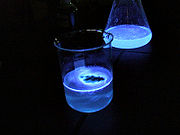Luminescence
- Understand the several forms of luminescence
- Understand basis of energy release during luminesence
- duration of luminesence phenomena
- metastable states
- detrapping of electrons
You should know about energy levels in an atom.
Luminescence
From Wikipedia, the free encyclopedia
 |
Wikimedia Commons has media related to: Luminescence |
Luminescence is light that usually occurs at low temperatures, and is thus a form of cold body radiation. It can be caused by chemical reactions, electrical energy, subatomic motions, or stress on a crystal. This distinguishes luminescence from incandescence, which is light generated by high temperatures. Historically, radioactivity was thought of as a form of "radioluminescence", although it is today considered to be separate since it involves more than electromagnetic radiation.
The dials, hands, scales and signs of aviation and navigational instruments and markings are often coated with luminescent materials, in a process known as luminising.
The following are types of luminescence:
- Chemoluminescence
- Crystalloluminescence
- Electroluminescence
- Mechanoluminescence
- Photoluminescence
- Radioluminescence
- Sonoluminescence
- Thermoluminescence
External links
- Luminescence on Scienceworld
- Fluorophores.org The database of luminescent dyes
- Luminiscent microspheres
This article is licensed under the GNU Free Documentation License. It uses material from the article "luminescence".
